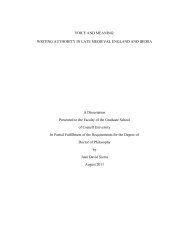CARPET WEAVERS AND WEAVING IN THE ... - Cornell University
CARPET WEAVERS AND WEAVING IN THE ... - Cornell University
CARPET WEAVERS AND WEAVING IN THE ... - Cornell University
Create successful ePaper yourself
Turn your PDF publications into a flip-book with our unique Google optimized e-Paper software.
competitive in both the tourist and export markets, and some tourists prefer the<br />
simpler designs in and of themselves (Jirousek 1994, 232).<br />
While Western conceptions of the “authentic” Turkish carpet may or may not<br />
have been influenced by the “aging” techniques practiced by dealers, Western<br />
aesthetics most definitely influenced the types of carpets being woven. When<br />
asymmetry came into vogue in Europe and the U.S. in the late 19 th century more<br />
prayer rugs, which have a pointed design at one end only, were woven; when<br />
Westerners wanted symmetrical furnishings prayer rug weaving became much less<br />
common (Jirousek 1994). According to Landreau, “the romantic notions about rugs<br />
disseminated by a Western elite created a mystique that greatly enhances, and<br />
continues to support, marketability.” Thus, through dealers and weavers catering to<br />
this Western notion, foreign aesthetics are important to design (1996, 301).<br />
It remains to be seen how contemporary carpets compare to those written about<br />
in the existing literature. Have carpets finally reached the white-on-white stage that<br />
would culminate the trend observed by Jirousek in 1994? There is also need for an<br />
evaluation of the changes in carpets in relation to recent changes in the global<br />
economy, as well as an exploration of whether or not weaving for sale affects the<br />
design and structure of carpets woven for home use.<br />
2.4.4 Government involvement in the weaving industry<br />
Berik notes that weaving, being part of an agricultural lifestyle and requiring no<br />
materials unavailable in rural Turkey, was encouraged under the Turkish<br />
government’s import-substitution industrialization strategy initiated during the First<br />
Five Year Development Plan in 1963. Policy up to the point of Berik’s research<br />
focused mainly on export promotion, and not on the weavers themselves. The<br />
government recommended that workshops and cooperatives be formed in order to<br />
34

















